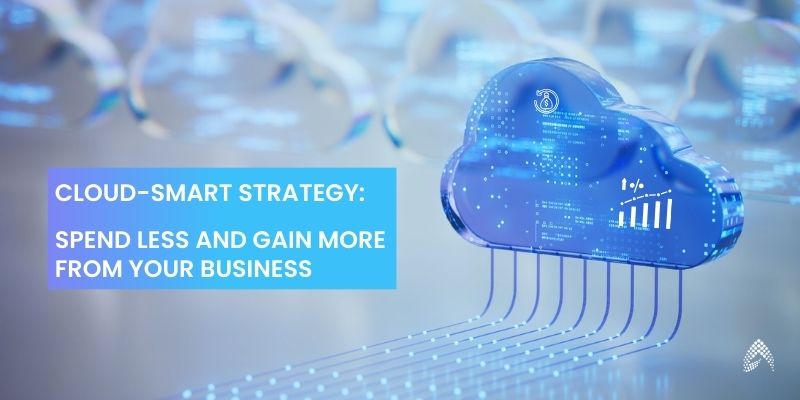Cloud-Smart Strategy: Spend Less and Gain More From Your Business

Over 97% of IT leaders plan to expand their cloud landscape in 2024, with 85% of organizations projected to adopt a cloud-first strategy. However, a “cloud-first” approach may lead to inefficiencies, including limited flexibility, potential security risks, and unexpected rises in cost when every application is moved to the cloud. [Ref]
Consider a Cloud-smart strategy that aligns cloud initiatives with specific business goals, optimizes deployment models, and ensures ongoing cost management to maximize cloud benefits.
What is a Cloud-Smart Strategy?
A cloud-smart strategy transcends the simplistic practice of migrating existing infrastructure to the cloud. It emphasizes a holistic perspective that aligns cloud initiatives with organizational goals and objectives.
This methodology incorporates several key principles:
1. Business-Driven Alignment: The cloud becomes a strategic enabler, not an independent objective. Through collaborative stakeholder engagement, the cloud-smart approach ensures that cloud initiatives directly address identified pain points and contribute to achieving pre-defined business goals.
2. Hybrid and Multi-Cloud Flexibility: Recognizing that a singular cloud solution may not be universally optimal, a cloud-smart strategy embraces a hybrid or multi-cloud model. This allows organizations to leverage the strengths of different cloud providers and on-premises infrastructure to create a customized environment that best suits their specific needs.
3. Workload Right-Sourcing: Cloud-smart strategies acknowledge the heterogeneity of application landscapes. Workloads are meticulously evaluated based on performance requirements, security considerations, and cost implications. This analysis informs the selection of the most suitable deployment model (public cloud, private cloud, or on-premises) for each workload, ensuring optimal performance and cost efficiency.
4. Continuous Optimization: The cloud-smart approach is an ongoing process, not a one-time event. By implementing robust monitoring practices and cost optimization techniques, organizations can leverage the latest cloud features, maximize resource utilization, and mitigate the risk of cloud sprawl.
A Case Study: Optimizing Retail Operations with a Cloud-Smart Strategy
Consider a retail organization facing limitations due to inflexible on-premises infrastructure, hindering their ability to scale during peak seasons. A cloud-smart strategy would outline the following:
- Public Cloud Migration for the E-Commerce Platform: Migrating the e-commerce platform to a public cloud environment enables rapid scaling of resources during peak sales periods. This translates to enhanced customer experience and reduced downtime during high-traffic periods.
- On-Premises Retention of Legacy Inventory Management System: Since this application may not require frequent scaling, maintaining it on-premises can potentially offer greater cost-effectiveness.
- Hybrid Cloud API Gateway Implementation: To ensure seamless integration between the cloud-based e-commerce platform and the on-premises inventory system, a hybrid cloud API gateway can facilitate real-time data exchange, enabling accurate stock management.
Use cases of Public, Private, and Hybrid Clouds in the Cloud-Smart strategy:
Public Cloud Use Cases:
When to Use:
- Non-Sensitive Data and Applications: Ideal for hosting non-sensitive data and applications where security and compliance are less of a concern.
- High Scalability Needs: Suitable for applications that require high scalability and flexibility, such as seasonal workloads or marketing campaigns.
Example:
Data Analytics: Leveraging public cloud platforms like AWS or Google Cloud for big data analytics to process vast amounts of production data and gain insights into operational efficiencies.
Private Cloud Use Cases:
When to Use:
- Sensitive Data and Applications: Best for hosting sensitive data and mission-critical applications that require stringent security and compliance controls.
- Regulatory Compliance: Necessary for industries with strict regulatory requirements where data sovereignty and compliance are paramount.
Example:
ERP Systems: Hosting enterprise resource planning (ERP) systems on a private cloud to ensure data security, compliance, and integration with existing manufacturing processes.
Hybrid Cloud Use Cases:
When to Use:
- Flexible and Integrated Workloads: Suitable for workloads that require both on-premises and cloud resources, providing flexibility and seamless integration.
- Bursting Capabilities: Ideal for scenarios where on-premises infrastructure needs to be supplemented with public cloud resources during peak demand periods.
Example:
IoT and Edge Computing: Deploying IoT devices on the factory floor that collect data and send it to a hybrid cloud environment for real-time analytics and decision-making. Critical data can be processed locally (edge computing), while aggregated data is sent to the public cloud for deeper analysis.
When to Consider a Cloud-Smart Strategy:
- Facing limitations with on-premise infrastructure that hinder growth.
- Seeking to improve data analytics and gain real-time insights.
- Aiming to increase agility and respond faster to market changes.
- Prioritizing cost optimization and reducing IT expenses.
- Looking to leverage cutting-edge cloud technologies for innovation.
Measuring Success with Cloud-Smart KPIs:
- Cost Reduction: Track IT infrastructure and software licensing cost savings.
- Application Performance: Monitor application response times and resource utilization.
- Increased Innovation: Measure the number of new products and services launched using cloud-based solutions.
- Improved Collaboration: Track enhanced communication and project completion timelines across teams.
- Security Posture: Monitor security incidents and measure the effectiveness of cloud security measures.
What’s your choice:
A cloud-smart strategy offers a balanced, optimized approach to cloud adoption, driving efficiency, innovation, and cost savings while maintaining robust security and compliance standards.
Align your cloud initiatives with business goals and achieve measurable results. Learn more about various cloud adoption strategies and understand how they can help you in the transformation journey.

Director – Global Delivery




